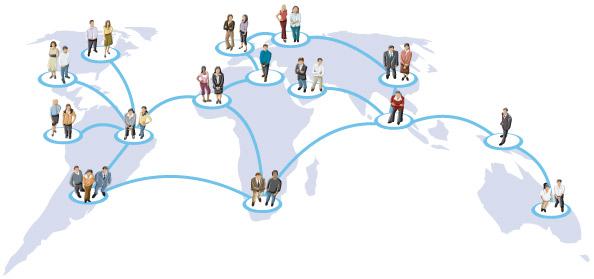Social Networks Makes Youth More Vulnerable
A social network website allows those who have an account to communicate with a selected group of friends. Social networking has become hugely popular.

Hundreds of social networks is in existence today, and the most popular one-Facebook-has some 800 million members, with half of this population being youths. According to a recent study carried out by the National Institute on Mental illness, more than 200 million youths between the ages of 15 and 19 are members of a social networking site and over 100,000 have become vulnerable in several ways having being introduced to these sites. The increasing number of youths who are members of Social networking sites each year has led many to wonder about its effects on these pliable young people. Extensive research and case studies on the issue has garnered much support for the view that social networking sites have made youths more vulnerable. Others have concluded that there is not much evidence to prove that social networking sites are responsible for the vulnerability of youths and as such they point to the myriad of other social, psychological and physical factors which accounts for their vulnerability. Despite the fact that there are a number of reasons which cause youths to become vulnerable, these do not hide the fact that social networking sites makes some youth vulnerable.
Social networking sites violate the privacy of youths, increasing their vulnerability. A study carried out by Mandel (2011) revealed that social networking sites made youths more vulnerable to identity theft. When youths upload pictures and personal information about themselves on social networking sites, it is very easy for hackers to hack in their profile, steal their pictures and duplicate a profile pretending to be the real person. A study carried out by Dale and Lewis (2011) also showed that social networking sites makes youth vulnerable as profile information, photos, status updates, and profile comments could reveal too much about them. Profile information and status updates could reveal personal things such as where the youth live, when and when not they are at home and as well where they go to school. Information such as these makes youths vulnerable to sexual harassment, bullying and theft (Willard, 2008).
There is also much hypothesis that youths are affected psychologically through their use of social networking sites. Mandel (2011) carried out a case study experiment and found that the popular websites frequent profile statuses, pictures and message updates made youths vulnerable by letting them see a 'skewed view of reality', which would make them feel as if they are not good enough. Psychologist Larry Rosen conducted a research on the issue as well and his findings were similar to Mandel's. Rosen found that youths who used social networking sites were more likely to show signs of psychological disorders such as antisocial behaviours, mania and aggressive tendencies. Additionally, science lecturer Celeb in a research found that youths who used social networking sites spent zero to one hour studying, while they spent up to five hours each day on social networks. As a result of this, these youths received lower grades in school in comparison to those students who were not members of a Social Networking site (Celeb, 2011). However, these studies are often times criticized for a lack of methodological validity as behaviours which include anti-social behaviours, mania and depression is merely caused by environmental, psychological and social factors such as family life, economical distress or ones psychological make-up (Salmon, pg 195). Despite the fact that this claim may be true to an extent, it still does not negate the studies which clearly supports the claim that the use of social networking sites has made youths more vulnerable by affecting their psychological capacity.
Survey studies on the issue have also been carried out by the American Psychological Association who clearly supports the view that social networking sites makes youths more vulnerable. American journalist Jill Tucker found youths, especially girls who used social networking sites to be more vulnerable at damaging their reputation than those who did not use them. Tucker outlines that "youths always say things on their profile page or on other people profile page that they normally would not say in person" (Tucker, p.g.120). However, Tucker's study has been largely criticized for hasty generalization by saying that profile comments makes youths more vulnerable to damaging their reputation, as it is believed that he failed to take into account the situation which had arisen at the time (such as easy access) causing youths to use social networking sites to highlight their views and opinions. Tucker is also criticized for not taking into consideration the positive effects which social networking via profile comments (for example, the posting of upcoming school events, class assignments, group assignments/meetings, the loss of a loved one and information on future social events) have on youths (Welsh, 2010). Nevertheless, there is a true point that there is a number of contributing social, psychological and physical factors which makes youths more vulnerable. However, these factors cannot overlook other factors-like social networking sites which makes youths vulnerable.
Another opposing view on the vulnerability of youths and social networking sites is the gratification theory. Proponents of this view believes that social networking does not make youths vulnerable especially when it comes to their grades as there is no 'correlation with social network use and grades.' The proponents of the study also argue that social networking sites do not affect grades negatively and it is just a matter of how students manage their free time. Gratification theorists also holds the view that the main focus should be on how teachers can actually use these social networking sites as a teaching method for their students and how the students can be encouraged to increase their communication skills on these sites. However, this view is lacking in substantial evidence as it fails to provide factual or researchable evidence in its statement that social networking sites do not make youths more vulnerable, especially as it relates to their academic performances.

It can thus be concluded then that social networking sites make some youths vulnerable. The mass of extensive research has drawn the same conclusion that social networks makes youth more vulnerable. To deny this claim is no different from denying the implications which alcohol has on a pregnant woman and her unborn child. Therefore, it is in the hands of parents to monitor their children's daily activities on these sites, to ensure that youths are not left alone with a computer , to set boundaries when and when not to visit these sites and to ensure that their personal information is private. This will decrease the vulnerability of our youths on these social networking sites, which will be of benefit to themselves, families, friends and the wider society.